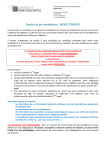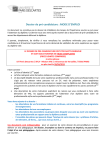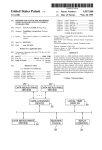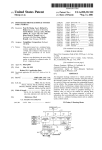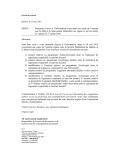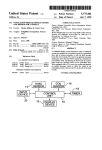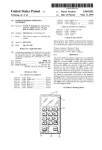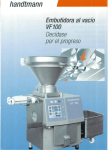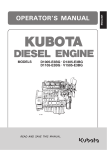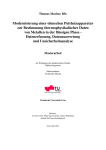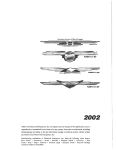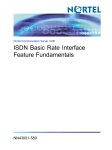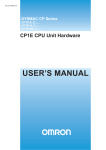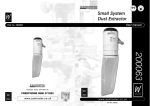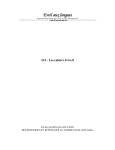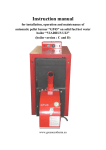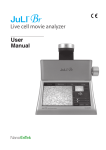Download Fuel use efficiency system for a vehicle for assisting the driver to
Transcript
US006092021A Ulllted States Patent [19] [11] Patent Number: Ehlbeck et al. [45] [54] 6,092,021 Date of Patent: Jul. 18, 2000 FUEL USE EFFICIENCY SYSTEM FOR A 4,747,301 5/1988 Bellanger ............................. .. 73/117.3 VEHICLE FOR ASSISTING THE DRIVER T0 4,845,630 7/1989 IMPROVE FUEL ECONOMY 4,945,759 8/1990 Krofchalk et a1 5,017,916 5/1991 . 5,074,144 12/1991 [75] Inventors‘ JGaéleltezs lgi'n?grlbgcslgiigagnéeé?gish" 5,148,702 . dA P Jare - ’H_ Chg, ’ h "We > L “Stop er r“, 5,303,163 5,652,378 5,693,876 [73] Assignee: Freightliner Corporation, Portland, 0mg Londt et a1. ...... .. 73/117.3 340/87013 Krofchalk et a1. ................... .. 73/117.3 9/1992 Gulick, Jr. .............................. .. 73/114 4/1994 Ebaugh et a1. .. 701/35 . 340/439 7/1997 Dussault .... .. 73/114 12/1997 Ghitea, Jr. ............................... .. 73/114 Cadec, Celect RoadRelayTM, User’s Guide, Cadec Systems, Inc., Londonderry, NH, Cummins Electric, 1993. _ Flyer, Detroit Diesel, ProDriverTM, User Manual, 1994. Flled' Dec' 1’ 1997 Operating and Error Codes, Series 925/205, FloScan Instru [51] Int. Cl.7 .............................. .. G06G 7/70; G01L 3/26 [52] US. Cl. ............................. .. 701/123; 701/29; 73/113; 73/114; 73/1173; 73/115 [58] . . . .. 701/123 OTHER PUBLICATIONS [21] Appl- NO-I 08/982,117 . ........ 5,173,856 12/1992 Purnell e161. .. - both of Portland, Oreg- [22] Stephens Field Of Search .............................. .. 701/30 29 123 701/32; 73/113, 114, 112, 116, 115, i173: 119 A; 340/439, 325.06, 462, 870.16, 436, 870~13> 461; 123/478> 480; 477/100> 42> 43> 107 _ [56] Inent Company, Inc, S9a?19,WA, 4/93' C_at9rp_i11ar©, Owner’s Manual, Caterpillar Driver Informa Hon D1sp1ay,F9b-, 1995 J01"” SAE/TMC Electronic Dam Interchange Between Microcomputer Systems in Heavy—Duty Vehicle Applica "0% 1988 Primary Examiner—Jacques H. Louis-Jacques Attorney, Agent, or Firm—Klarquist Sparkman Campbell Leigh & Whinston, LLP References Cited 57 U.S. PATENT DOCUMENTS [ 1 _ ABSTRACT Afuel ef?ciency monitoring and display system for a vehicle """"""""""""""" " dynamically evaluates vehicle performance parameters to 4’157’030 6/1979 Keely _______ _____ _ 73/113 detect conditions that cause excessive fuel consumption. 4:247:757 4,258,421 1/1981 Crump’ 1L 3/1981 JuhasZ et a1, 73/114 701/35 The conditions include increased aerodynamic drag due to excessive speed, high RPM, braking and accelerating, 4,384,479 5/1983 Handtmann . . . . . . . . . . .. 73/114 excessive idling, and rapid throttle movements. The system 4,400,779 8/1983 Kosuge et a1 4,475,380 10/1984 colovas et a1~ ~~ 701/123 dynamically estimates gross vehicle Weight, roadWay grade (sgnifer """ a ’ ''''' 73/114 '''' to man“ 6 a‘ " to the driver When inefficient fuel use is detected. For glicslflilgeettagi """ " 4’57O’226 2/1986 Aussedat 4,663,718 4,706,083 example, it displays a measure of excess fuel consumed and """701/123 4j630:027 12/1986 Muhlberger et a1_ 5/1987 Augello et a1. .... .. and drag factor from monitored parameters and uses these estimates to detect inef?cient fuel use. The system indicates 701/30 messages indicating actions that can be taken to improve fuel economy in response to detecting inefficient fuel use. .. 73/114 11/1987 BaatZ et a1. ............................. .. 73/113 54 Claims, 13 Drawing Sheets INPUT MODULE 180 l 1 128 6 122 5 SELECTED MGIDPLIJELE l VEHICLE PERFORMANCE PARAMETERS EXCESS \\ f MODULE 124 l F—-— DISPLAY DR‘VER MODULE 182 THROTTLE f192 DRIVER P’ MESSAGE CENTER 126 @184 _. PARAMETER W186 (CRUISE) U.S. Patent Jul. 18,2000 FIG. 1 22 ENGINE J ECU ECU J LINsTRuMENTATION CONTROL UNIT DATA PORTW 26 30 FIG-2 56 1 RPM THROTTLE. SPEED FUEL CONTROL POSITION A 52 CRuIsE STATUS >8 6,092,021 28 24 2 ECU 2° W I Sheet 1 0f 13 INJECTOR 7 L A 50 48 46 MEMORY l‘" " "/1, ‘ =CPU V 10 PORT 4g INTERFACE 44 A S V ( 20J FIG_ 3 ’ DISPLAY II MEMORY II S2 6Q 66 ROM J 67 = RAM , , , CPU J 68 EEPROMJ II PORT W INTERFACE 64 A V 20-1 U.S. Patent Jul. 18,2000 FIG. 4 Sheet 2 0f 13 6,092,021 104 ,/ 100 (NORMAL DRIVING MESSAGE) J 8.4 MPG 191321.? MI 106 108 F G. 5 110 112 ,/ f , 102 0.6 MPGAIN J (PROMPTING MESSAGE) 114 SER'AL INPUT J 0201 —~ I + / 128 VPE f MODULE 122 l INPUT DATA EXCESS f MODULE 124 1 1 ‘ DISPLAY K DR'VER 126 DRIvER _ MESSAGE V CENTER U.S. Patent Jul. 18,2000 Sheet 3 0f 13 6,092,021 START VPE II CONVERT MONITORED PERFORMANCE DATA V0=VCURRENT II I CALCULATE V, TORQUE, HP, AND BRAKE STATUS RESET n FSum V’\2 Sum %GR, VSUm II N=N+1 I COMPUTE AVERAGE ACCELERATION I COMPUTE CURRENT TRACTIVE FORCE, F ‘I UPDATE FSum VSUm VAZSUm _/156 COMPUTE DIFFERENCE BETWEEN ACTUAL AND ESTIMATED VELOCITY 0 FIG. 7A U.S. Patent Jul. 18,2000 Sheet 4 0f 13 6,092,021 160 IS VEHICLE SUSTAINING HIGH ACCELERATION NO SET GAIN TO ZERO _) SET GAIN FOR VEHICLE WEIGHT ESTIMATE BASED ON V ESTIMATE _/ 'I 66 GROSS WEIGHT II ESTIMATE ROADWAY GRADE _/168 ‘I SMOOTH VARIATIONS f17o IN GRADE CALC. II UPDATE THE _/172 DRAG FACTOR I RETURN |:|G_ 75 U.S. Patent Jul. 18,2000 Sheet 5 0f 13 6,092,021 FIG. 8 F180 SELECTED ‘1| r184 E PARAMETER W186 VEHICLE MODULE PERFORMANCE ~ PERCENT _/188 PARAMETERS THROTTLE L SPECIFIC FUEL _/190 K182 CONSUMPTION , THROTTLE _/192 (CRUISE) 200 VEHICLE NOT BEING RETARDED & HP EXCEEDS THRESHOLD ' I 204 MAINTAIN YES r202 J CURRENT Sa UPDATE SHORT TERM AVERAGE SPEED, Sa ‘7 FIG. 9A YES (-208 SET TO PREDETERMINED VALUE V I U.S. Patent Jul. 18,2000 Sheet 6 0f 13 6,092,021 208 DIFFERENCE BETWEEN CURRENT SPEED AND S8. EXCEED LIIXIIT YES (-210 INCREMENT/ DECREMENT CURRENT SPEED LIMIT FIG. 9B YES 214 SET SLim 7/ I CALCULATE INCREMENTAL 216 HORSEPOWER REQUIRED J TO OPERATE VEHICLE AT SPEEDS EXCEEDING SLlm COMPUTE EXCESS FUELguoEmTsgmo INCREASED DRAG 4 II RETURN 2'26 EXCESS FUEL : FP, II J v / EXCESS FUEL=O U.S. Patent Jul. 18,2000 Sheet 7 0f 13 6,092,021 START RPM II 240 COMPUTE CURRENT J ENGINE SPEED LIMIT, ESL II CALCULATE AND COMPARE CURRENT RATIO OF VEHICLE 242 SPEED TO ENGINE SPEED / WITH PREVIOUS RATIo FIG. 10 244 RATIOS WITHIN LIMIT & MPH < L_SLlm (TP > mIn OR TC=1) '7 248 SET RATIO STATUS SET RSI _/246 TO ZERO IND_II%A;I'OR II CALCULATE INEFFICIENT FUELUSED FoR EXCESS RPM II RETURN f 250 __J U.S. Patent Jul. 18,2000 Sheet 8 0f 13 IDLEIE‘EIILC ' SETIDLING 272 PARAMETER .J 6,092,021 FIG. 11 NOTIDLING 276 CURRENT IDLE TIMER > I LIM ADD CURRENT INCREMENT .J OF FUEL TO THE INEFFICIENT FUEL CONSUMED v INCREMENT CUMULATIVE 580 AND CURRENT IDLE TIMERS < V RETURN ‘' 54 U.S. Patent Jul. 18,2000 Sheet 11 0f 13 NO BRAKES & 6,092,021 354 BRAKE : BAI & TP <9Tmin l RAt = o _ 358 ‘ CALC. MODIFIED BRAKE 360 RELEASE SPEED / 376 / 0 / |BRSC=MPHI |BRSC=O| j 382 FIG. 12C U.S. Patent Jul. 18,2000 IS CURRENT Sheet 12 0f 13 F400 6,092,021 FIG. 13 NO SFC > SFCa*REFERENCE & MP_H > LSLIm ’) ‘YES CALCULATE INCREASE IN SPECIFIC FUEL CONSUMPTION II CALCULATE RATE OF 406 _.J CHANGE IN THROTTLE TRATE > TLim OR PREVIOUSLY EXCESSIVE NO ‘7 YES CALCULATE INEFFICIENT _) FUEL CONSUMED II RETURN ' U.S. Patent Jul. 18,2000 Sheet 13 0f 13 6,092,021 FIG. 14 @ ACCUMULATE ACTUAL /-42() FUEL CONSUMED I ACCUMULATE EXCESS FUEL f422 DURING CURRENT INTERVAL I UPDATE TOTAL [424 EXCESS FUEL I ACCUMULATE EXCESS FUEL f426 CONSUMED FOR EACH SOURCE II FIG. 15 440 NO DISABLE DISPLAY IIPAESSAGE FIG. 16 4 YES | 4 REsET PARAMETER 442 P ® UPDATE FILTERED ‘ DETERMINE WHICH DRIVING 344 TYIPA%§T%>D(NCSE%I§H§SETLHE v ASSIGN DISPLAY $46 VARIABLE 460 j EXCESS FUEL I 462 | UPDATE FILTERED FUEL I) I 464 UPDATE FILTERED J THROTTLE POSITION ‘ ‘I RETURN UPDATE AVERAGE SPECIFIC FUEL CONSUMED II 466 6,092,021 1 2 This embodiment includes an output device, namely a FUEL USE EFFICIENCY SYSTEM FOR A VEHICLE FOR ASSISTING THE DRIVER TO IMPROVE FUEL ECONOMY display device, to indicate a measure of the excess fuel consumed due to a detected condition that has caused the vehicle to consume excess fuel. It also uses the output device to provide the driver With prompting messages indicating the TECHNICAL FIELD cause of the excess fuel consumption and a driver action that can be taken to reduce excess fuel consumption. For The invention relates to a fuel ef?ciency indicator in a vehicle, and more speci?cally relates to a system for example, in response to detecting excess fuel consumption dynamically detecting inefficient driving actions and indi cating information about excess fuel consumption to the driver. due to braking and accelerating, the display prompts the 10 Other types of output devices can be used to convey this information to the driver such as an audio speaker to provide BACKGROUND OF THE INVENTION With rising fuel costs, an important design goal of vehicle information systems is to provide drivers, and especially drivers of long-haul trucks, With information about fuel economy during operation of the vehicle. Many vehicles the information aurally. 15 BRIEF DESCRIPTION OF THE DRAWINGS FIG. 1 is a block diagram illustrating the system archi in miles per gallon. While this information is helpful, it does not give the driver speci?c feedback on hoW speci?c driving actions impact fuel economy. In addition, it fails to provide tecture in a truck for one embodiment of the invention. a measure of excess fuel consumption due to speci?c types 25 Modern motor vehicles are typically equipped With a variety of onboard computers for measuring and recording vehicle performance and diagnostic data. These devices provide a great deal of information about the performance of the vehicle during operation. The problem is not lack of information, but rather, evaluating it and conveying it to the compute and display information about inef?cient driving indicator that uses this data to assist the driver to operate the vehicle more ef?ciently and take actions that avoid excess 35 SUMMARY OF THE INVENTION The invention provides a fuel ef?ciency system and related method that indicate When the driver is operating the vehicle inef?ciently. This system provides feedback to the driver When the vehicle is consuming excess fuel due to implementation of the Vehicle Parameter Estimation Mod ule of FIG. 6. FIG. 8 is a block diagram depicting a parameter sub module in the excess module shoWn in FIG. 6. FIGS. 9A and 9B are a How diagram of speed sub-module in the excess module for detecting inef?cient fuel use due to speeding. FIG. 10 is a How diagram of an RPM sub-module in the excess module for detecting inef?cient fuel use due to inef?cient driving actions. It monitors vehicle performance data and dynamically analyZes the data to determine When the driver’s actions result in inef?cient fuel use. When the FIG. 2 is a block diagram illustrating the engine electronic control unit (ECU) in more detail. FIG. 3 is a functional block diagram illustrating the architecture of the instrumentation control unit (ICU). FIG. 4 is a diagram of a display format generated by the ICU in FIG. 3 to display normal driving messages. FIG. 5 is another diagram of a display format generated by the ICU to indicate inef?cient driving conditions and suggest an action to improve fuel efficiency. FIG. 6 is a How diagram illustrating modules used to conditions in one embodiment of the invention. FIGS. 7A and 7B are a flow diagram illustrating an driver in a useful fashion. There is a need for a fuel ef?ciency fuel consumption. Further advantages and features of the invention Will become apparent With reference to the folloWing detailed description and accompanying draWings. display a measure of fuel economy such as the gas mileage of driving actions. Drivers are less likely to get information that can help them improve fuel economy from these fuel economy measures, and thus, are more likely to ignore them. driver With a text message stating, “Drive Steady Speed.” 45 operating the vehicle at a high RPM. FIG. 11 is a How diagram of an idling sub-module in the system detects a condition that cause the vehicle to consume excess module for detecting inef?cient fuel use due to excess fuel, it indicates the presence of the condition to the driver. In one embodiment of the invention, the fuel ef?ciency excessive idling. FIGS. 12A—C are a ?oW diagram of a braking/ accelerating sub-module in the excess module for detecting inef?cient fuel use due to frequent braking and accelerating conditions (i.e., fuel lost due to changes in kinetic energy of system displays a message indicating that fuel inef?cient driving has been detected. In addition, the system also the vehicle). provides the cause of excess fuel use and suggests an action that the driver can take to fuel economy. This embodiment also computes the amount of excess fuel consumed due to inef?cient driving and displays a measure of it to the driver. FIG. 13 is a How diagram of a throttle sub-module in the excess module for detecting inef?cient fuel use due to rapid 55 throttle movement. In this embodiment, the system monitors several inef? FIG. 14 is a How diagram of a total sub-module in the cient driving conditions, including excessive speed leading to increased aerodynamic drag, high engine RPM, excessive idling, frequent braking and accelerating, and rapid throttle excess module for accumulating fuel consumption values. FIG. 15 is a How diagram of a display sub-module in the excess module for determining Whether to display a message regarding inef?cient fuel use for an inef?cient driving action evaluated in the excess module. FIG. 16 is a How diagram of an average sub-module in the excess module for ?ltering selected variables. movement. During operation of the vehicle, the system dynamically determines Whether these inef?cient driving conditions are present. In evaluating the vehicle perfor mance data, the system evaluates performance parameters to distinguish betWeen inefficient and normal driving actions. When inef?cient driving is detected, the system computes a measure of excess fuel consumed due to the inef?cient driving action. 65 DETAILED DESCRIPTION One embodiment of the invention is a fuel ef?ciency monitoring and display system implemented using elec 6,092,021 3 4 tronic control units onboard a truck. In particular, this embodiment includes an instrumentation control unit for detecting and displaying information about inef?cient driv speed control 50 senses the speed of rotation of the tail shaft of the transmission and converts it into road speed. A magnetic sensor located on the tail shaft generates an analog ing conditions, and one or more control units or discrete signal comprised of a series of pulses representing the sensors for monitoring vehicle performance data. The next section describes the system architecture of the electronic rotation rate of the tail shaft or drive shaft. This analog signal is converted into a digital signal. The engine ECU is programmed to read this digital signal and derive the instan taneous vehicle speed in miles per hour. The engine ECU is responsible for monitoring a variety of control units onboard a vehicle in this embodiment. Later sections describe an implementation of the fuel ef?ciency system and related methods in more detail. The System Architecture FIG. 1 is a block diagram illustrating the system archi 10 vehicle performance data in an embodiment of the inven tion. The system architecture includes a number of elec tronic control units (ECU) interconnected via a data link 20. In particular, the system shoWn in FIG. 1 includes an engine ECU 22, located at the engine, and an instrumentation control unit 24, located at the dash of the truck. As shoWn, other optional ECUs 26, 28 can be connected to the data link 20. Finally, the system includes an optional data port 30, for coupling external data processing equipment to the ECUs on and turbo boost pressure. These parameters are transferred to the instrumentation control unit over the data link. The Instrumentation Control Unit 20 FIG. 3 is a functional block diagram illustrating the architecture of an instrumentation control unit (ICU) used to detect inefficient fuel/use and control a driver display in one implementation of the invention. The instrumentation con trol unit comprises a CPU 60, memory 62 and a port interface 64 for connecting the unit to the data link 20. The 25 RAM 67 and permanent ROM 68. The routines for control ling the ICU are stored in ROM 68, While re-con?gurable data is stored in the EEPROM 68. In one speci?c implementation, the ICU includes a 15 memory 62 includes programmable ROM (EEPROM) 66, board the truck. This data port enables an external computer, for example, to receive and transmit messages on the data link. It also enables an external computer to doWnload data or a ?le to an ECU and to receive data or a ?le from an ECU. The Engine Control Unit FIG. 2 is a block diagram illustrating the engine ECU used to collect vehicle performance data in the system shoWn in FIG. 1. The engine ECU includes memory 40, a CPU 42, and a port interface 44 connected via a bus structure 46. The CPU 42 executes routines stored in the memory 40 other vehicle performance parameters, including RPM, and throttle position. It derives engine torque from the fuel rate, tecture of electronic control units in a truck used to monitor 68HC11 microprocessor from Motorola Corporation, and its memory 62 comprises EEPROM, ROM, and RAM. This speci?c ICU has 8 KB of external EEPROM, 128K of ROM to control and monitor engine performance. The port inter and 2K of RAM. The internal memory of the CPU comprises 256 Bytes of RAM and 512 bytes of EEPROM. This is only one speci?c implementation of the ICU. A variety of con face 44 serves as a link betWeen the CPU 42 and a serial ventional processors and memory systems can be used to 30 communication path called the data link 20. implement the functionality of the instrumentation control The engine ECU also includes a variety of sensors and controls used to monitor and control the engine. In this unit. Preferably, the processor used in the ICU should be a 16 bit processor. The processor used in the current implemen tation Was selected to have suf?cient speed and memory to be able to evaluate ?ve different fuel inef?cient driving 35 implementation, the engine ECU controls the fuel rate by issuing control signals to a fuel injector 48 that controls the How of fuel to the engine’s cylinders. This implementation of the ECU includes several sensors that monitor vehicle performance, including a speed sensor 50, an RPM sensor conditions every 200 ms. This is not an absolute 40 requirement, hoWever, since the number of inefficient driv Some vehicle performance parameters are computed from ing conditions that are monitored and the response time can vary. measured data. For example, the engine torque is computed The ICU also preferably includes an input device 70 and 52, a throttle position sensor 56 and a cruise status sensor 58. a display device 72. In one implementation, the input device as a function of measured parameters, including fuel rate and 45 is a ten key keypad 70, but the speci?c design of the input turbo boost pressure. The engine ECU controls the fuel rate and serves as a fuel device can vary. The design of the input device can vary. The rate measuring device for the system. It compares the throttle position to the percent engine load. If their is a display device 72 provides a textual and graphical output to the driver display. In one speci?c implementation, the dis difference, then the engine ECU changes the dWell time of the fuel injector (increases or decreases the fuel injected into the cylinder). Before the engine ECU applies the dWell to the play device comprises a tWo line by 20 character vacuum fuel injector, it processes the dWell time further to limit emissions. The emission control computation can modify factured by Joseph Pollak of Boston, Mass. for Freightliner Corporation. The instrumentation control unit is presently the injection timing and dWell. In this implementation, the engine ECU determines the amount of fuel supplied to the cylinders in the engine by controlling the solenoid valves that inject fuel to the engine cylinders. The rate of fuel How is directly related to the amount of time that the solenoid valve is closed. This time period determines the volume of fuel injected into a cylinder per revolution. By determining the amount of time that the solenoid valves are closed, the engine ECU computes the amount of fuel consumed by the engine. The engine ECU calculates the fuel ?oW rate from the dWell of the injection pulse and the engine speed. The engine ECU in this embodiment is also responsible for measuring and computing the vehicle’s road speed. The ?uorescent display. The particular ICU used in this implementation is manu 55 available as a replacement part from Freightliner Corpora tion. The Data Link The data link 20, in this implementation, is a serial communication path connecting the ECUs together. This 60 particular data link is designed according to SAE J 1708, a standard for serial data communication betWeen microcom puter systems in heavy duty vehicle applications. While this speci?c embodiment is based on the J 1708 standard, it is not critical that the invention be implemented in this speci?c manner. One possible alternative is to use a data link 65 constructed according to SAE J 1939. The communication link need not be a shared communication path. It is also possible to connect vehicle parameter sensors (i.e., for road 6,092,021 5 6 speed, fuel rate, RPM, torque, throttle position, etc.) directly In some cases tWo or more transmitters may attempt to to the ICU via discrete Wiring. In the embodiment shoWn in FIG. 1, the data link 40 is comprised of a tWisted pair cable operating at 9600 baud. Designed according to the SAE 11708 standard, the data link broadcast a message at one time, giving rise to a collision. To resolve a con?ict among transmitters, messages have a priority according to their message identi?ers. The MIDs of higher priority transmitters have a greater number of bits set forms a communication channel among the electronic con at a logic level one. When more than one message is broadcast at a time, the more dominant message takes trol units coupled to it. Electronic control units generate a digital signal on the data link by applying a voltage differ ential betWeen the tWo Wires in the cable. A voltage differ ential above a speci?ed threshold represents a logic high value, While a voltage threshold beloW a speci?ed threshold represents a logic loW value. This type of data link is priority over lesser dominant messages. Since a loWer pri ority message is blocked by a higher priority message, the 10 particularly advantageous for hostile environments because the signal is more robust and impervious to signal degrada tion. HoWever, other alternative communication media could be used in place of the 11708 cable. 15 The ECUs connected on the netWork communicate With each other according to protocols de?ned in SAE 11708 and SAE 11587. The SAE 11587 standard is entitled “1oint SAE/TMC Electronic Data Interchange BetWeen Micro computer Systems and Heavy Duty Vehicle Applications.” transmitter of the loWer priority message must Wait and retransmit the message after another lull. An ECU on the data link Will continue to attempt to send a message until it 20 is successfully broadcast to the data link. As introduced above, the ICU obtains vehicle performance data from the data link and uses selected parameters to detect inef?cient driving conditions and compute eXcess fuel con sumed. Table 1 beloW summariZes the selected parameters from the data link that the ICU uses to monitor fuel ef?ciency. This standard de?nes one format for data and messages communicated among microprocessors connected to a TABLE 1 shared data link, and is speci?cally adapted for use With PID 84 Speed SAE 11708. According to SAE 11708/11587, the ECUs on the data link 25 PID 85 Throttle or Cruise/Service Brakes PID 89 Power Take Off (Bit 8) PID 91 Throttle Position Engine Torque communicate by passing messages to each other. The ECUs PID 93 can be either receivers, or receivers and transmitters. In this PID 121 Engine Retarder Status particular implementation, the instrumentation control unit PID 183 PID 190 Fuel Rate RPM and the engine ECU are both transmitters and receivers. For the purpose of monitoring vehicle performance data, the 30 engine ECU acts as a transmitter, sending messages to the Fuel Ef?ciency Monitoring and Display System ICU regarding road speed, fuel rate, engine torque, RPM, throttle position, engine status, etc. In this format, a message includes the folloWing: 1) a module ID (MID), 2) one or more parameters (the message data), and 3) a checksum. The number of parameters in a message is limited by the total message length de?ned in the SAE 11708 standard. The message identi?cation numbers are assigned to transmitter categories as identi?ed in SAE 11587. The MID portion of a message speci?es the origin or transmitter of the message. In the majority of cases, mes 35 40 sages are broadcast on the data link Without specifying a receiver. HoWever, the message format can be eXtended to include the MID of a receiver after the MID of the trans mitter for special applications. The messages passed among the ECUs convey information 45 about one or more parameters contained Within the mes sages. According to the SAE 11587 standard, the ?rst character of every parameter is a parameter identi?cation folloWs the PID. The SAE 11587 supports different data formats including a single character, a double data character or more than tWo data characters representing the parameter data. Several parameters can be packed into a message, limited by the maXimum message siZe as noted above. each other over the data link according to the SAE standard 55 11708. The standard describes methods for accessing the data link and constructing messages for transfer over it. It ers only act on a message if programmed to do so. eXcess fuel. The display in FIG. 5 replaces the one in FIG. 4 When the system detects a condition Where the vehicle is consuming eXcess fuel. The fuel ef?ciency messages tell the driver When the vehicle is consuming eXcess fuel, the cause of excessive fuel can take to save fuel. The fuel ef?ciency values are numeri 60 cal representations of fuel ef?ciency. There are a variety of different display formats that can be used to convey fuel ef?ciency messages and values to the driver, and FIGS. 4 and 5 represent only one eXample. In the eXample shoWn in particular implementation, the length of the lull is 200 milliseconds. After detecting this lull, the ECU attempts to transmit its message. The transmitter broadcasts its message onto the data link. Each of the ECUs that operate as receivers on the data link Will receive the message. HoWever, receiv the driver. During normal driving conditions, the message display provides normal driving messages. When the system detects fuel inef?cient driving, it changes the display to consumption, and messages indicating actions that the driver also de?nes a method for resource contention among the ECUs on the data link. An ECU Wishing to transmit data on the data link ?rst Waits for a lull in transmission of data on the data link. In this messages to prompt the driver When it detects that eXcess fuel is being consumed and suggests a driving action that Will improve fuel economy. FIGS. 4 and 5 illustrate eXamples of a message display used to provide vehicle performance messages and values to indicate that the vehicle is consuming eXcess fuel and suggests an action that Will improve fuel ef?ciency. FIG. 4 is an eXample of a display 100 used to display normal driving messages, While FIG. 5 is an eXample of a display 102 informing the driver that the vehicle is consuming character (PID). The parameter identi?ed by the PID directly Again, in this implementation, the ECUs communicate With The system architecture described above is used to imple ment a fuel efficiency monitoring and display system. The system monitors vehicle performance parameters and deter mines When the vehicle is consuming eXcess fuel. It displays a combination of graphical and numerical quantities repre senting fuel efficiency and the eXcess fuel consumed due to a fuel inef?cient driving action. In addition, it displays 65 FIG. 4, the display 100 shoWs “normal driving” messages 104, the current fuel economy in miles per gallon 106, and an odometer reading 108. Alist of some eXamples of normal driving messages are in Table 2 provided beloW. 6,092,021 8 7 The Vehicle Parameter Estimation Module The VPE module 122 estimates the vehicles Weight TABLE 2 (GCW), aerodynamic drag factor (Beta) and the gradient NORMAL DRIVING MESSAGES (Grade) of the roadWay. These estimates are derived from information available from electronically controlled engines plus an analog signal from the engine fan clutch (analog MPG Bargraph OUTSIDE TEMP xxx F COOLANT TEMP xxx F OIL PRESSURE xxx PSI ENGINE OIL TEMP xxx F FUEL TEMP xxx F BATTERY xx.x VOLTS FUEL xx.xx GAL/HR TURBO BOOST xx PSI 10 TUE JUN 24 11:21 AM In an alternative implementation, the display shows other fuel efficiency information during normal driving conditions (i.e., When inef?cient driving is not detected). For example, 15 input 130). The estimated values are updated once per second and recorded in memory for use by the other mod ules. The Excess module The Excess module 124 determines the incremental por tion of the fuel being consumed to operate the vehicle (if any) attributable to each of the fuel inef?cient driving types. Once this is determined, the folloWing information is updated and logged in memory of the ICU: 1) driving type consuming the largest increment of fuel inef?ciently; one alternative display format shoWs the fuel required to 2) inef?cient fuel consumed (start of trip to current point); 3) trip fuel (start of trip to current point); 4) short term inef?cient fuel (geometric averaged); and ef?ciently operate the vehicle divided by the actual fuel consumed. It also displays the miles per gallon (current fuel consumption) and an odometer reading. The ICU continu ally updates fuel ef?ciency data and presents messages and 5) short term trip fuel (geometric averaged). values to the driver in real time. The short term inef?cient and trip fuel are used to calcu late the numeric value of “FUEL EFFICIENCY” Which is Whenever the ICU detects fuel inef?cient driving, it changes the format of the display in FIG. 4 to another format such as the one shoWn in FIG. 5. The display 102 in FIG. 5 25 shoWs a bargraph 110 and a numerical value 112 depicting displayed to the driver. The Display Driver Module could be gained by taking the action suggested by the text The Display Driver module 126 reads the analog inputs from the dash mounted driver operated keypad (Analog input 130) to select preprogrammed messages available for message 114 displayed beloW it. display in the driver message center. Current numeric values the magnitude of the improvement in fuel economy that (if needed) are inserted into the message displayed. One of the options available to the driver is the display 100 shoWn TABLE 3 in FIG. 4. Driving Type Prompting Message Speeding DRIVE XX — MPH Gain x.x MPG High Engine RPM SHIFT TO NEXT GEAR Excessive Idling * * *END IDLING" * * Braking/Accelerating DRIVE STEADY SPEED Rapid Throttle MOVE THROTTLE SLOWER SoftWare Description 35 Gain x.x MPG SAVE x.xx GAL/Hr The logic employed in each of these softWare modules is described in the folloWing sections. The Input Module The Input module 120 employs a parser to select, parse and record into the array (called the PID array) all messages from the engine ECU. The ICU receives vehicle perfor mance data from the data link in a serial data stream. As noted above, messages on the data link include an ID, Gain x.x MPG Movement folloWed by one or more parameters, and a checksum. The Gain x.x MPG One implementation of the fuel ef?ciency system com prises four softWare modules executing from memory on the ICU. FIG. 6 is a block diagram illustrating these modules. The folloWing four modules are executed repetitively to compute fuel ef?ciency data and update the display on the parser, executing in the ICU, uses the ID to identify the message and the siZe of the parameters in the message 45 is valid, it updates the PID array With the parameters from the message. dash of the vehicle: 1) INPUT 120, 2) VEHICLE PARAM ETER ESTIMATION 122, 3) EXCESS 124, and 4) DIS At poWer on, all values in the PID array are set to Zero. This module is executed as frequently as possible to insure that the most current information from the engine control unit is available for use by the other softWare modules. Flags PLAY DRIVER 126.—It is important to emphasiZe that these modules represent one implementation of the inven tion and that the implementation can vary depending on a number of factors, such as the type and architecture of the performance monitoring devices in the vehicle, the type of vehicle (long haul tractor trailer truck, business class truck, car, etc.) the speci?c inef?cient driving conditions that are monitored, etc. The Input Module The input module 120 converts serial input data 128 from (single byte or multi-byte data), and temporarily stores the parameters in memory of the ICU. The parser then veri?es that the data is valid by evaluating the checksum. If the data 55 are set Whenever updated engine torque (PID 93 once per second), fuel rate (PID 183 ?ve times per second) or RPM (PID 190 ten times per second) messages are received. The Vehicle Parameter Estimation Model The VPE module 122 utiliZes the information generated by the INPUT module to estimates the vehicle’s Weight (GCW), aerodynamic drag factor (Beta) and the gradient (Grade) of the roadWay. Unless otherWise stated, informa the serial data bus into an array of asynchronous numeric tion from the prior iterations is read from memory as an values Which are updated as neW messages are received. input at poWer on, and updated and stored in memory When the system is poWered doWn. This module is executed once Receipt of selected messages from the engine control unit is used to indicate 100 millisecond, 200 millisecond and one per second When the engine torque (PID 93) information is second time intervals. These time intervals are used to signal 65 updated and recorded in memory for use by the other the arrival of neW data and clock several of the subsequent modules. VPE utiliZes the folloWing inputs de?ned in Table modules. 4: 6,092,021 9 10 Otherwise, it sets Case=0 Part 2 of the VPE Module Part 2 has two cases. If Case (from Part 1) equals Zero, then the variables n, FSum, VA2Sum, % Gr and VSum are set equal to Zero (146) and the value of the variable Vo equal to TABLE 4 VARIABLE DEFINITION % GR the gradient of the roadway which is iteratively estimated and updated by the VPE module. The initial the current vehicle velocity (148). startup value of % Gr is Zero. Beta the aerodynamic drag factor which is iteratively DTeff estimated and updated by the VPE module. The initial startup value of Beta is 0.085. the mechanical efficiency of the drivetrain. It is stored If Case equals one, then the VPE module increments the counter n by one; i.e., 10 as a constant in memory. FSum the sum of the longitudinal force driving the vehicle during each of the n iterations. The initial startup value GCW the estimated gross weight of the vehicle. hpL the average parasitic engine horsepower loss excluding n=n+1(step 150) It then computes the average acceleration (a) (152) using the equation of FSum is Zero. a=(V—V0)/n/32.2 15 the engine cooling fan. “hpL” is stored as a constant in memory. n and the current tractive force a counter which records the number of iterations F=550*HP*DTeff/V (seconds) of summing and updating of data. Its initial PID startup value is Zero. a 256 element data array which contains the most recent information from the 11587/1708 data bus for (154) using the equation Next, the VPE module updates the sums used for esti 20 mating the parameters as follows (156): MID 128 (Engine). PID is updated by the INPUT module. the rolling resistance coef?cient of the vehicle. It is r stored as a constant in memory. VA 2Sum VSum Vo the sum of the squares of the vehicles velocity during each of the n iterations. The initial startup value of VA2Sum is Zero. the sum of the vehicles velocity during each of the n iterations The initial startup value of VSum is Zero. 25 From this information, the difference between the actual and the estimated vehicle velocity (e) is computed using the following equation (158): the vehicles velocity at the start of the summing process. The initial startup value of V0 is Zero. 30 Vehicle Parameter Estimation or VPE includes two parts. If the vehicle is sustaining a high acceleration and torque The ?rst part (Part 1) uses information from the PID array (n>5 & a>0.011 & Torque>500)(decision step 160), then it selects the gain (p) for the vehicle’s weight estimate update to determine if the operating conditions are correct for updating the parameter estimates. The second part (Part 2) performs the necessary calculations and updates the param 35 eter estimates if the necessary conditions are met. FIGS. 7A and 7B are a How diagram illustrating the operation of both of these parts of the VPE module 122. The reference numbers associated with the steps in the How diagrams are set forth in parentheses next to the corresponding description in the text below. Part 1 of the VPE Module The ?rst part of the VPE module converts the data from selected elements in the PID array to the information used throughout VPE as shown in step 140 (FIG. 7A). In addition, p=100000. 40 Otherwise, it sets the gain to Zero, p=0 (164). The esti mated gross weight is calculated using the following equa tion (166): 45 In this implementation, the gross weight is computed incrementally based on the previous value of the gross Part 1 assigns the value of Zero or one to the variable Case weight, the gain factor (which depends on whether the vehicle is sustaining high acceleration and torque), the estimated velocity, and the rolling resistance. Next, the estimated percent roadway grade (gr) is calcu which is used as the basis for updating the parameter estimates. First, it calculates the value of the following variables as de?ned below (also see step 142, FIG. 7A). Part 1 of the VPE module sets a parameter, Brake, equal to one if either the brakes are applied (bit six of PID 85 is equal to one) or the engine retarder is operating (bit 8 of PID 121 is equal to one). The VPE module computes the vehicle velocity, engine torque and horsepower from selected PID values stored in as follows (162). If the vehicle’s velocity is less than 70 (V<70), the VPE module sets p=500000. If the vehicle’s velocity is not less than 70, it sets lated using the following equation (168): The variations in the estimated value of the roadway 55 grade are smoothed using the following equation (170): the PID array. V (vehicle velocity)=PID 84*07335 Torque (engine torque)=PID 93*20 HP (horsepower)=Torque*PID 190/21009-hpL 60 Finally, the VPE module updates the drag factor as shown in step 172. If the absolute value of the variation in the vehicle’s velocity is greater than 0.5 [abs(V—VSum/n)>0.5], The last step of Part 1 is to set Case=1 if all of the then the VPE module uses the following equation to deter mine if the estimated grade increased or decreased: following are met (decision step 144 of FIG. 7A): HP is greater than Zero, V is greater than 15, Brake=0, and n is less than 250. Dg=sign(Gr-gr), otherwise set Dg=0. 65 The sign function returns the value +1, 0 or —1 if the value of the argument (Gr-gr) is greater than, equal to or less than 6,092,021 11 12 zero, respectively. If the vehicle is operating at a sustained velocity greater than 70 with a low acceleration [V>70 & abs(a)<0.011], then the VPE module uses the following equation to determine if the vehicles velocity is increasing or TABLE 5-continued DTeff the mechanical e?iciency of the drivetrain. DTeff is Et the time in seconds since the brakes were last released. Et is initialized to zero when a new trip is inaugurated. The initial startup value of Et is zero. FPI the fuel per iteration. It is updated each iteration by stored as a constant in memory. decreasing: DV=sign(V—VSum/n), otherwise set DV=0. dividing the fuel rate (PID 183) by 1152000 which The VPE module then estimates the drag factor using the equation: provides the gallons of fuel consumed for each 200 ms interval. the estimated gross vehicle weight, an input from the 10 VPE module. IFuel Note that the drag factor is computed incrementally based on its previous value and whether the vehicle speed and grade are increasing or decreasing. The Excess Module One implementation of the Excess Module is composed of nine sub-modules which operate iteratively to identify the idle time limit. IFuel is initialized to zero when a new trip is inaugurated. The initial startup value of IFuel is 15 zero. ILim 20 memory as an input at power on, updated by one or more of updated—?ve times per second. The sub-modules within the a new trip is inaugurated. The initial startup value of ITime is zero 25 LSLim the minimum speed necessary before ine?icient fuel use is computed. Below this speed ine?icient fuel use is not MFuel the accumulated fuel (in gallons) used from the start of the trip due to rapid throttle movement. MFuel is computed. LSLim is stored as a constant in memory. TABLE 5 BAI BASc the accumulated fuel (in gallons) used from the start of the trip due to operating the vehicle at speeds above a predetermined speed, SLim. AFuel is initialized to zero when a new trip is inaugurated. The initial startup value of AFuel is zero. a brake application indicator which is set equal to one to show that an initial braked speed has been recorded. BAI initialized to zero when a new trip is inaugurated. The initial startup value of MFuel is zero. 30 Over 35 PID PID’s 0 through 253 from the J1587/1708 data bus for initialized to zero when a new trip is inaugurated. The initial startup value of BAI is zero. MID 128 (Engine). This array is updated by the INPUT the con?rmed brake application speed. It is calculated such that the difference in the vehicle’s kinetic energies between BASc and BRSc (see below) represents the accumulated braked change in the vehicle’s kinetic PTO 40 energy. BASc is updated by the Braking/Accelerating the time between release of the throttle and application of the brakes or release of the brakes and application of the sub-module and initialized to zero when a new trip is throttle. RAt is initialized to zero when a new trip is the vehicle speed (in mph) when the brakes are applied. RFuel 45 new trip is inaugurated. The initial startup value of RFuel is zero. RLim fuel. RLim is stored as a constant in memory. To accommodate various engine speed ratings, its value 50 should be initialized based on information from the engine ECU at power on. the vehicle speed (in mph) when the brakes are released. The Braking/Accelerating sub-module updates BRSp, Sa inaugurated. The initial startup value of BRSp is zero. initial start up value of Sa is 55. 55 SFCa VPE module. BFuel the accumulated fuel (in gallons) used from the start of the trip due to unnecessary braking/accelerating. BFuel is indicates when the vehicle is being retarded (Brake = 1) by either the service brakes or engine retarder. It is inaugurated. The initial startup value of SFCa is 0.05. SLim TBt ICU sets Cruise to one. an input which can be varied as the program is operating. the maximum time in seconds between release of the brakes and application of the throttle or release of the throttle and application of the brakes for these release status of service brakes (bit 6 of PID 85) and the engine retarder (bit 8 of PID 121). indicates when the vehicle is operating in cruise control (Cruise = 1). It is updated each iteration based of the value of bit 8 of PID 85. If bit 8 is set to one, then the the maximum speed in MPH which the vehicle can be operated before it is considered to be speeding. SLim is 60 updated each iteration by combining (logical OR) the Cruise the geometric average (or initial) speci?c fuel consumption of the engine in gallons per horsepower hour. SFCa is initialized to 0.05 when a new trip is initialized to zero when a new trip is inaugurated. The initial startup value of BFuel is zero. B rake the short term average vehicle speed in miles per hour for vehicle speeds greater than 55 and less than 75 mph. The which is initialized to zero when a new trip is the estimated aerodynamic drag factor, an input from the minimum engine speed in RPM above which increased engine speed is considered as ine?icient use of Braking/Accelerating sub-module updates BRSc which is initialized to zero when a new trip is inaugurated. The initial startup value of BRSc is zero. inaugurated. The initial startup value of RAt is zero. the accumulated fuel (in gallons) used from the start of the trip due to operating the engine at speeds greater than the engine speed limit. RFuel is initialized to zero when a inaugurated. The initial startup value of BASp is zero. represents the speed at which the vehicle’s brakes were last released which produced a con?rmed loss of kinetic energy — modi?ed by the speed/time criteria. The Beta module. indicates if the power take off is operating (PTO = 1). It is updated each iteration based of the value of bit 8 of PID 89. RAt BASp is updated by the Braking/Accelerating sub BRSp Consumption SFCa which is allowed before excess or ine?icient fuel is accumulated. Over is stored as a constant in memory. an array which contains the most recent information for is updated by a Braking/Accelerating sub-module and module and initialized to zero when a new trip is BRSc the maximum value of the ratio of current Speci?c Fuel consumption SFC divided by average Speci?c Fuel inaugurated. The initial startup value of BASp is zero. BASp the time in seconds which the engine has been idling for the current idling event. ITime is initialized to zero when Excess module utilize the following inputs: AFuel the accumulated time in seconds which the engine has been idling from the start of the trip. ITime is initialized to zero when a new trip is inaugurated. The initial startup value of ITime is zero. Itime the sub-modules and stored in memory when the system is powered down. Execution of all of these sub-modules is triggered when the fuel rate (PID 183) information is the maximum time in seconds which the engine can idle before engine idling is considered as ine?icient use of fuel. ILim is stored as a constant in memory. ITime unnecessary or inef?cient fuel use—if any. Unless otherwise stated, information from the prior iterations is read from the accumulated fuel (in gallons) used from the start of the trip due to idling the vehicle for periods longer than applications to be considered as ine?icient use of fuel. TBt is stored as a constant in memory. TFuel 65 the total fuel (in gallons) used from the start of the trip. T'Fuel is initialized to zero when a new trip is inaugurated. The initial startup value of TFuel is zero.
































